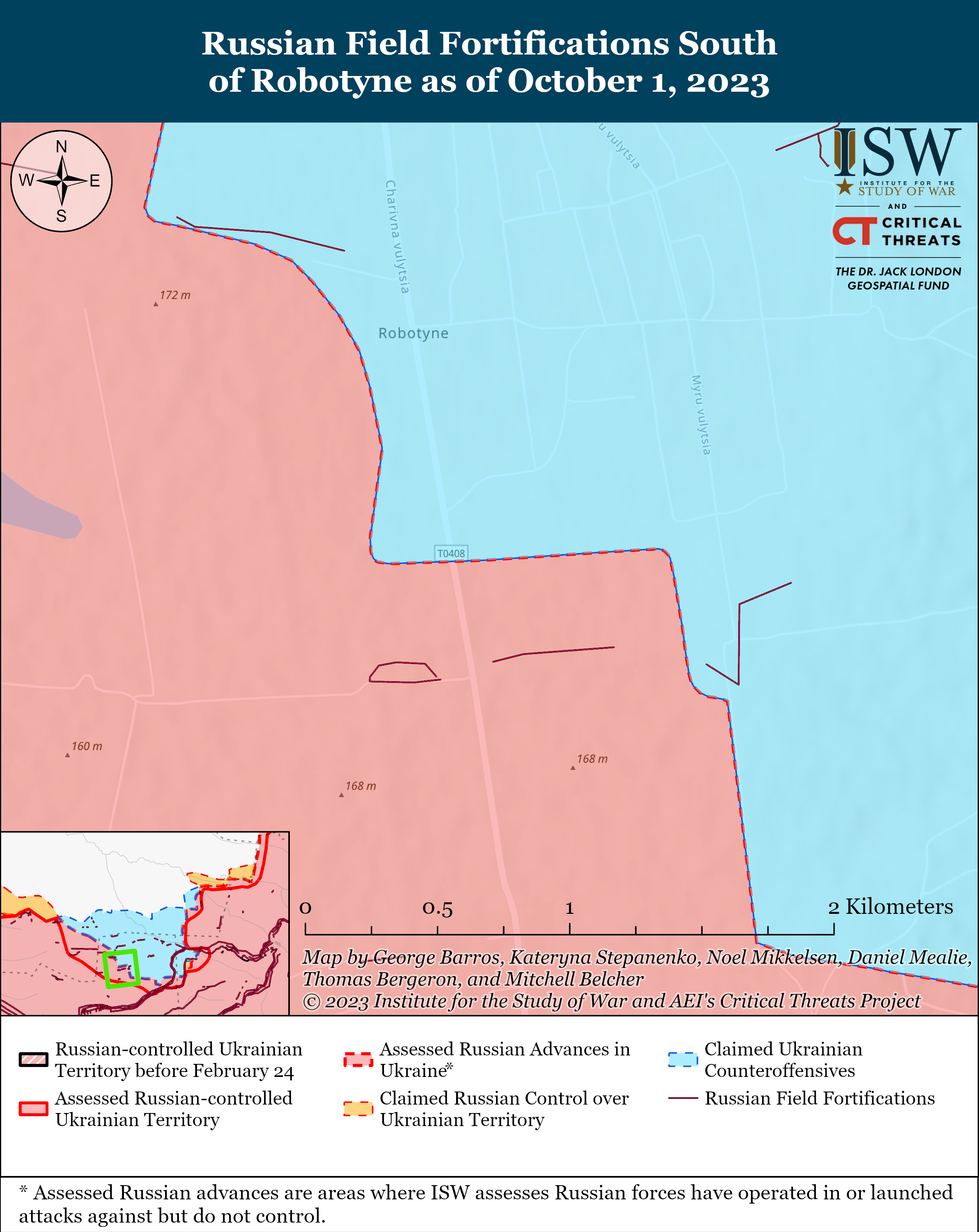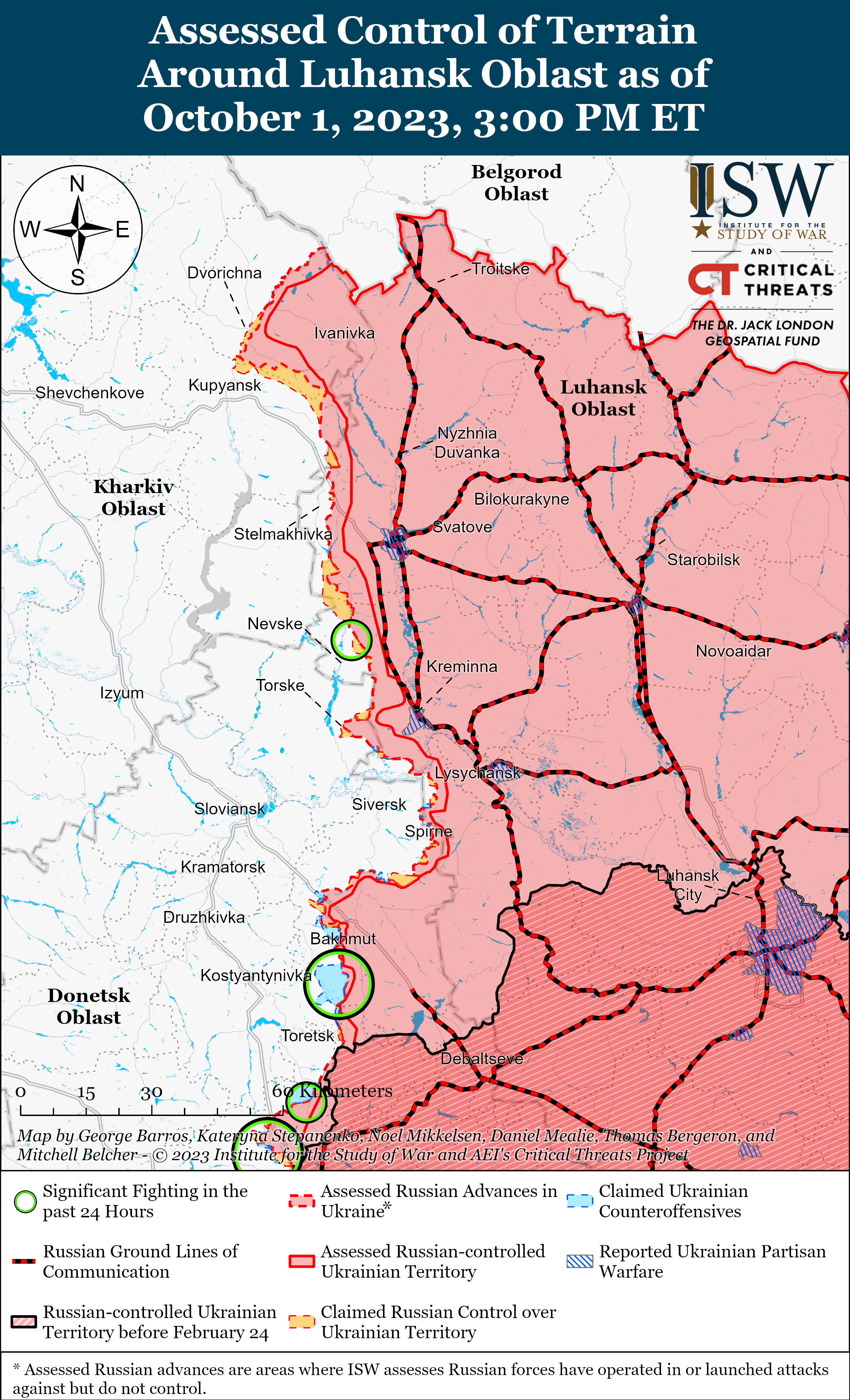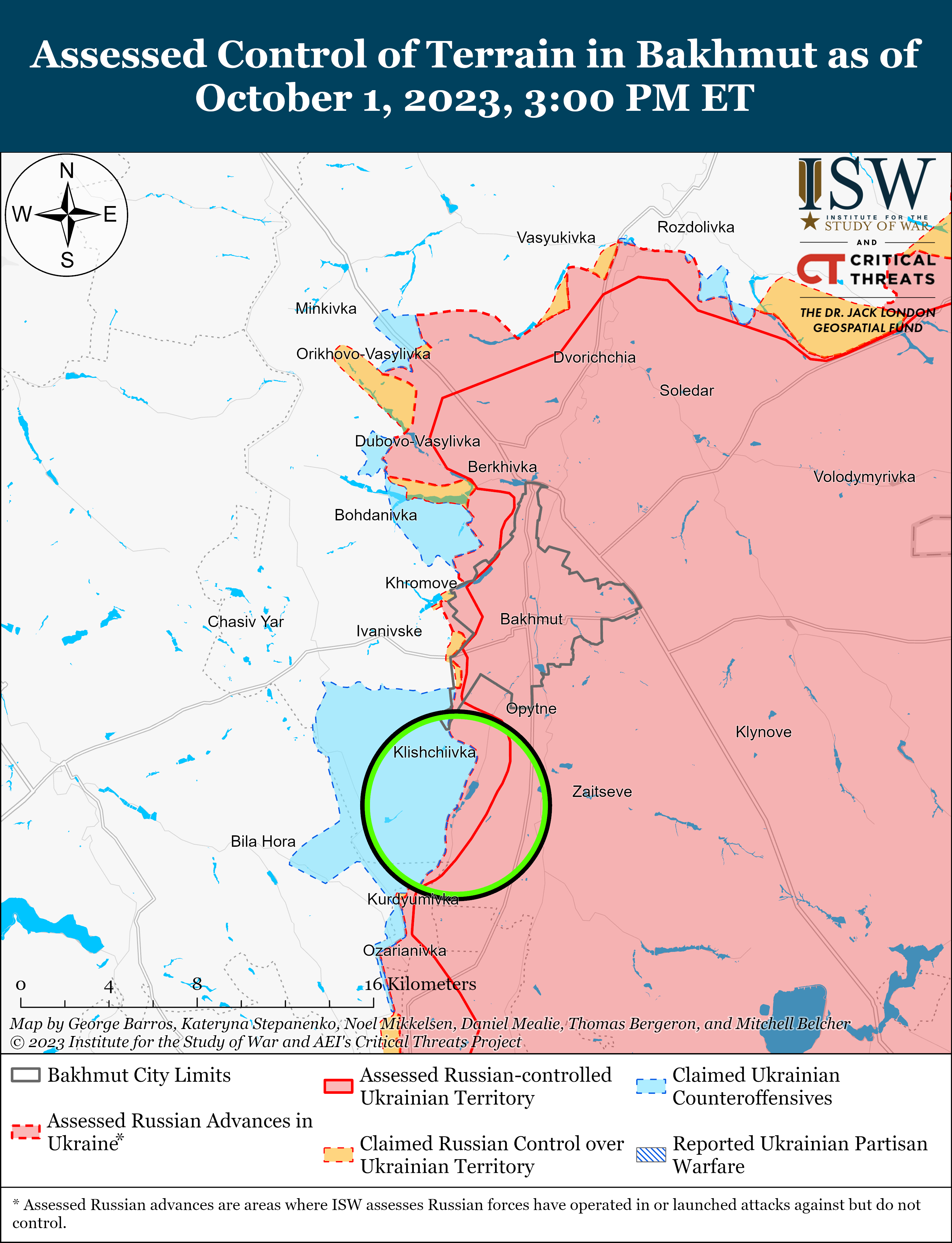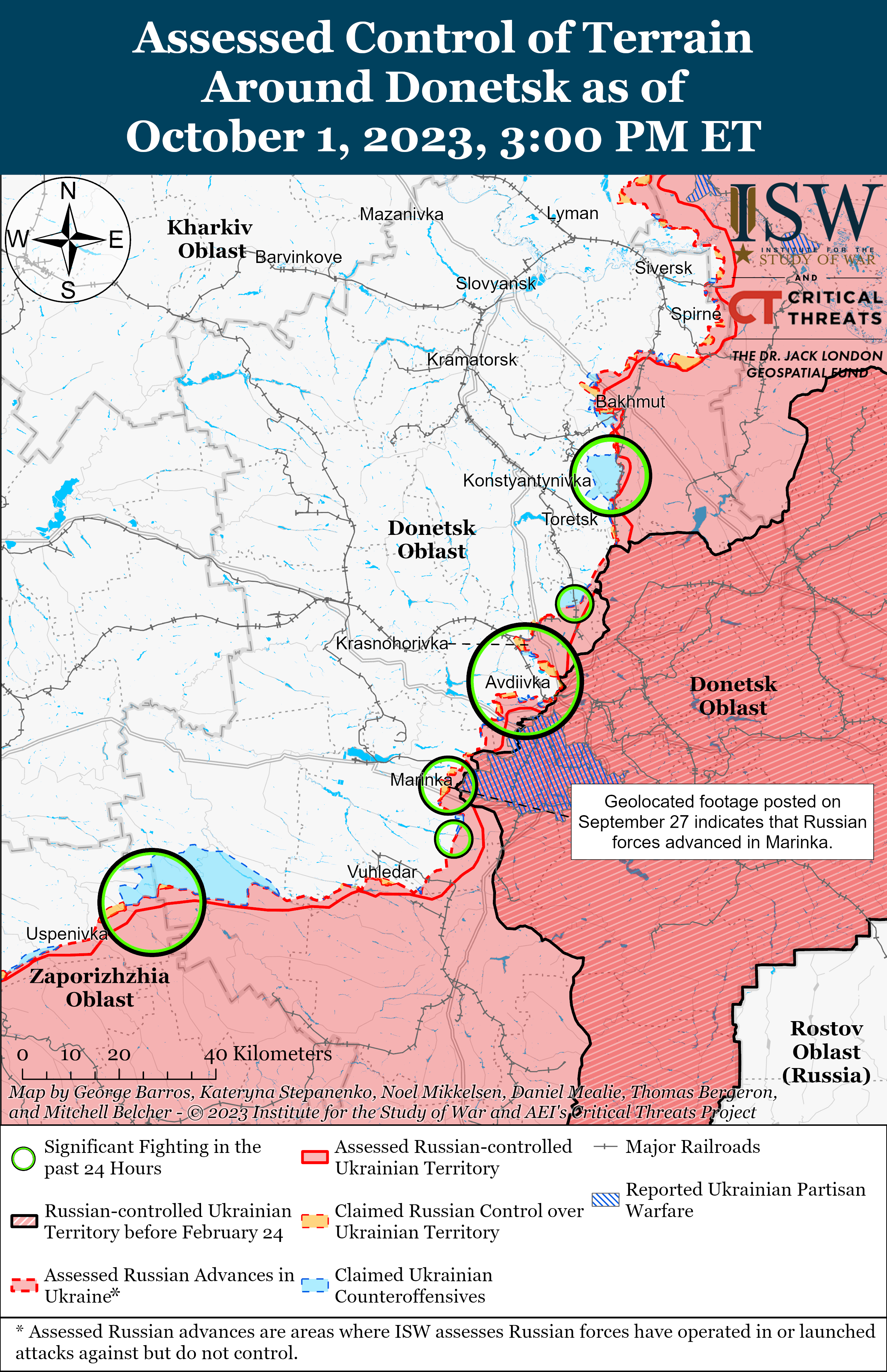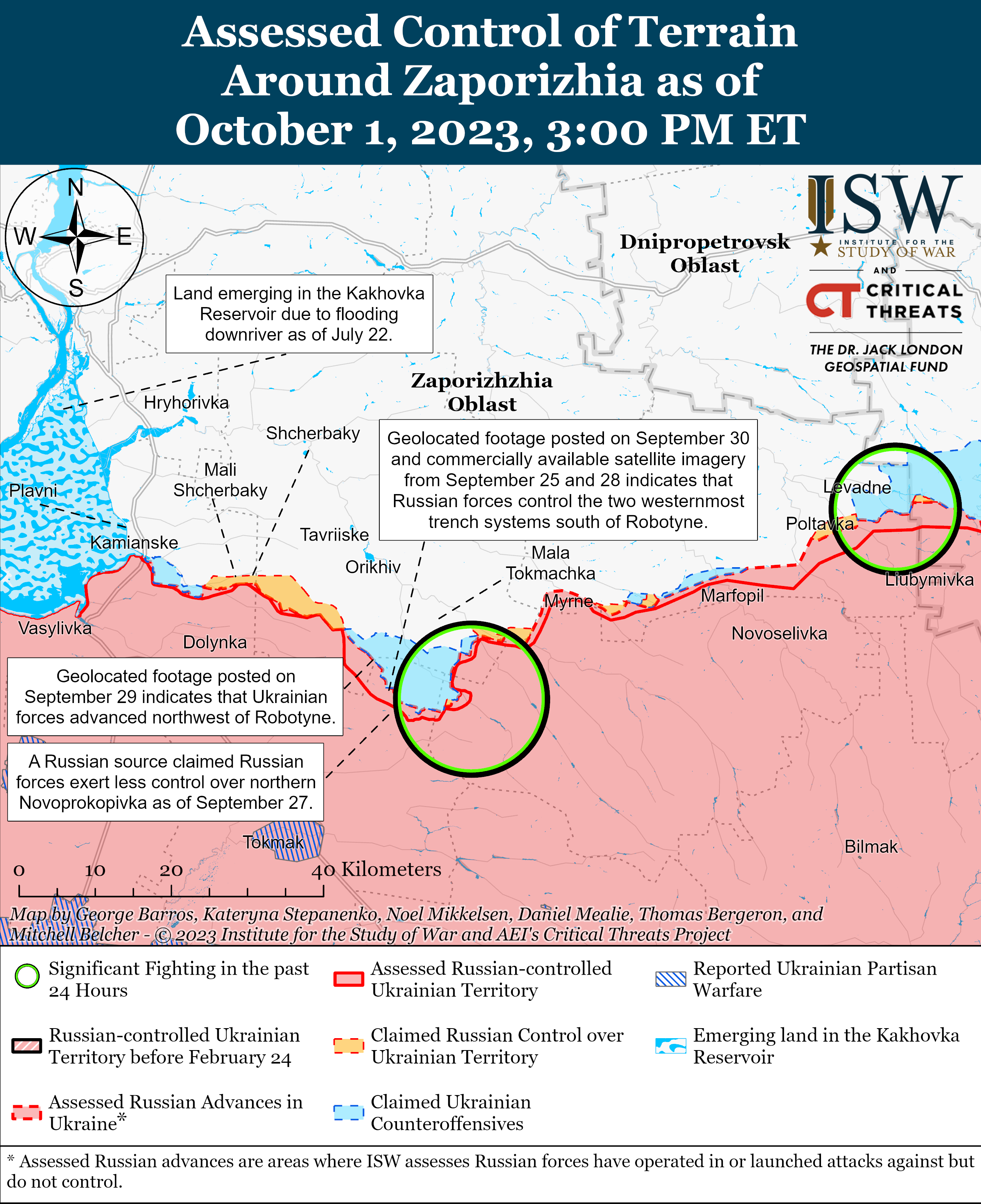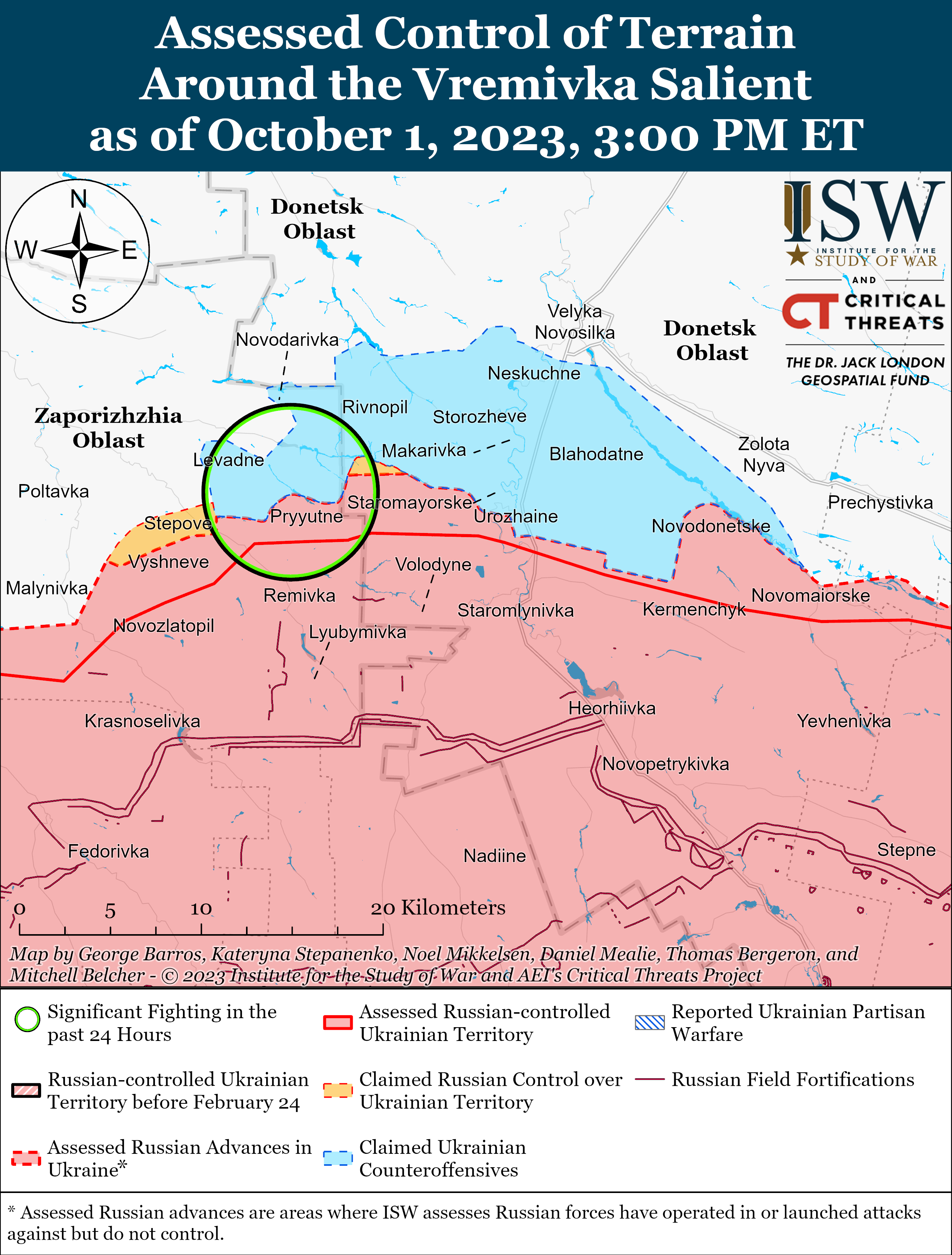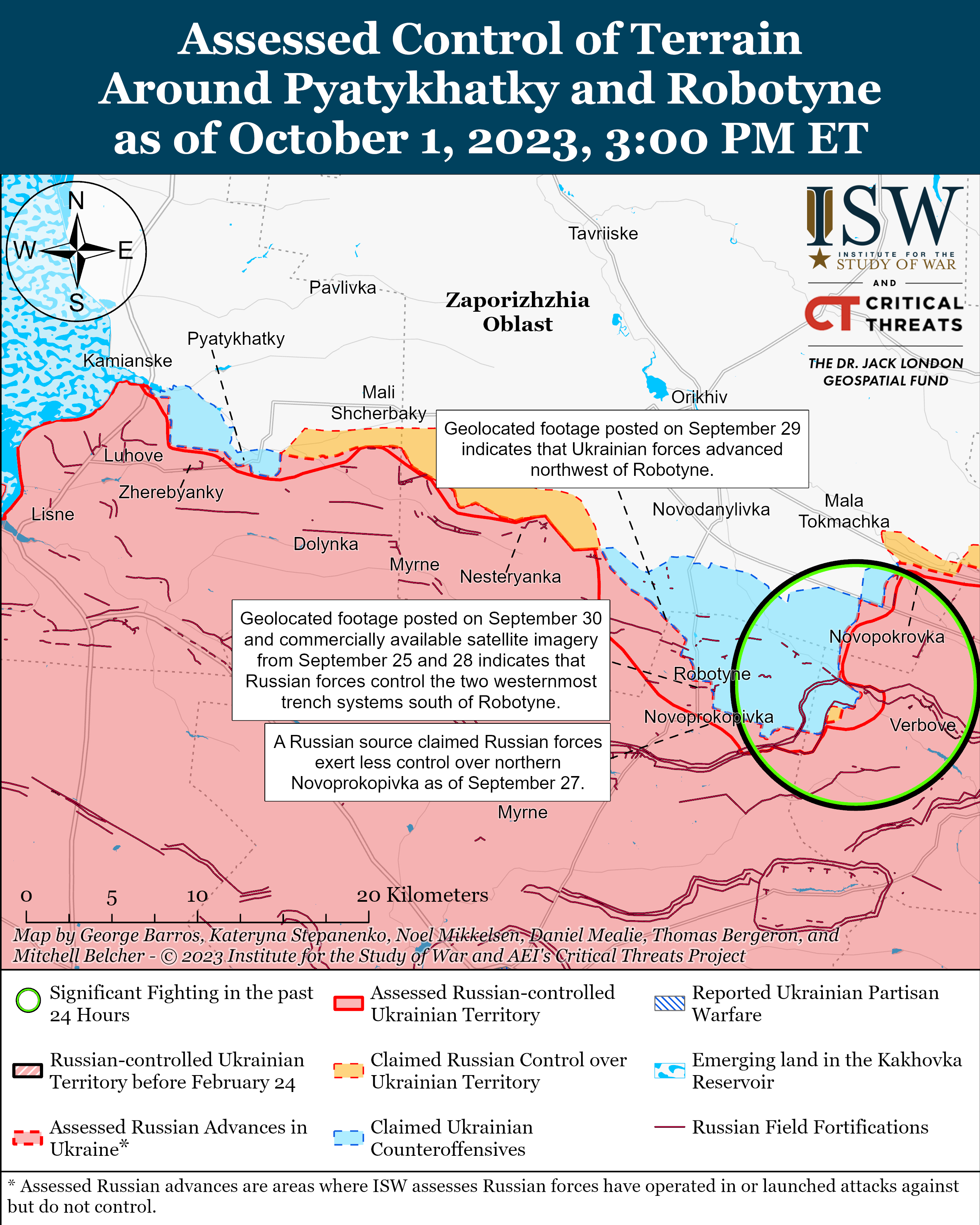 |
 |
Russian Offensive Campaign Assessment, October 1, 2023

Russian Offensive Campaign Assessment, October 1, 2023
Angelica Evans, Nicole Wolkov, George Barros, Karolina Hird, and Frederick W. Kagan
October 1, 2023, 5:30pm ET
Click here to see ISW’s interactive map of the Russian invasion of Ukraine. This map is updated daily alongside the static maps present in this report.
Click here to access ISW’s archive of interactive time-lapse maps of the Russian invasion of Ukraine. These maps complement the static control-of-terrain map that ISW produces daily by showing a dynamic frontline. ISW will update this time-lapse map archive monthly.
Note: The data cut-off for this product was 12:15pm ET on September 30. ISW will cover subsequent reports in the October 1 Russian Offensive Campaign Assessment.
Russian forces are conducting tactical counterattacks in the Robotyne area as part of their elastic defense against ongoing Ukrainian offensive operations in western Zaporizhia Oblast. The situation south of Robotyne is fluid as some tactically significant field fortifications have changed hands several times. Geolocated footage posted on September 30 shows Ukrainian forces striking Russian troops trying to enter a trench system about 1km southwest of Robotyne near the T0408 Robotyne—Tokmak road.[1] Footage posted on September 13 shows that Ukrainian forces had previously occupied segments of this trench and thus appear to have lost it to Russian counterattacks between September 13 and 30.[2] ISW has recoded this area from Ukraine's counteroffensive to Russian advances.
A Ukrainian soldier analyzed the footage of the area and noted that the aforementioned Russian-controlled trench is a strongpoint in an interconnected system of trenches, firing systems, and dugouts that lie between Robotyne and Novoprokopivka.[3] The Ukrainian soldier noted that the trenches are connected by underground tunnel-like structures and that Russian forces are prioritizing the defense of these positions, which have tactical significance in the area between Robotyne and Novoprokopivka.[4] Geolocated footage posted on October 1 shows Russian forces striking a Ukrainian vehicle just south of the middle of the three trenches and about 1km west of the easternmost trench in the system, suggesting that Ukrainian forces control the easternmost trench and are attempting to push westward to recapture the remaining two trenches and connected dugouts and firing positions.[5] Commercially available satellite imagery indicates that Russian forces destroyed this vehicle between September 25 and 28, indicating that Russian forces repelled a Ukrainian attack and reconsolidated Russian positions near the trench systems in late September. The reported continued presence of Russian forces in the western and central trenches suggests that Russian forces have been conducting successful limited tactical counterattacks south of Robotyne and that the tactical situation in this area is complex and dynamic.
The Russian information space continues to falsely portray Western aid to Ukraine as escalatory in order to discourage continued Western support for Ukraine. Newly appointed United Kingdom Defense Secretary Grant Shapps stated in an interview with the Telegraph published on September 30 that he held talks with unspecified (likely UK) “Army leaders” about moving “more training and production” of military equipment into Ukraine.[6] UK Prime Minister Rishi Sunak walked back Shapps’ statement on October 1 and stated that the UK has no immediate plans to deploy military instructors to Ukraine.[7] Sunak clarified that it may be possible for the UK to conduct some training in the future in Ukraine but stated that the UK would not send British soldiers to fight in the ”current conflict.”[8] Russian Security Council Deputy Chairperson Dmitry Medvedev, a notably nationalistic and extreme voice in the Russian government, called Shapps’ since-clarified statement a “push” toward a ”third world war.”[9] Medvedev regularly voices alarmist rhetoric and continues to portray any Western aid to Ukraine as escalatory in an attempt to undermine Western military aid to Ukraine.[10] His comments are part of a long-running Russian information operation along these lines and do not mark any sort of inflection.
Several Russian milbloggers also expressed baseless paranoia in response to UK officials’ statements by claiming with no evidence at all that the UK intends to help train Ukrainian forces for future operations in Crimea.[11] The milbloggers’ claims are likely also a part of a Russian information operation intended to portray Western military aid and continued support for Ukraine as escalatory. Russian milbloggers have noted broad indicators such as Ukrainian strikes on military targets in Crimea and on Russian Black Sea Fleet (BSF) assets to suggest that western forces are currently aiding Ukrainian forces in preparations to launch military operations in Crimea.[12] Ukrainian strikes against Crimea and BSF assets are more likely part of Ukraine’s interdiction campaign assisting Ukrainian counteroffensive operations in western Zaporizhia Oblast.[13]
The status of the Wagner Group remains unclear amid reported negotiations about the Wagner Group’s future cooperation with the Russian government. The Wagner Group’s main combat elements are split across several countries, including Belarus, the Central African Republic, Libya, and Mali, and there is no clear unified leader for the Wagner Group.[14] Russian President Vladimir Putin publicly embraced former Wagner Group commander and current Ministry of Defense (MoD) employee Andrey Troshev on September 29 and stated that he and Troshev discussed how Troshev would be involved in the formation of new volunteer detachments that perform combat missions primarily in Ukraine.[15] Some Wagner group elements reacted negatively to Putin’s embrace of Troshev and have now put forward an alternative leader. A prominent Wagner-affiliated Telegram channel announced on October 1 that Yevgeny Prigozhin’s 25-year-old son Pavel Prigozhin has taken over “command” of the Wagner Group, and that Pavel Prigozhin is negotiating with Rosgvardia about having the Wagner Group rejoin combat operations in Ukraine.[16] The prominent Wagner-affiliated source reported that Wagner fighters would not have to sign contracts with the Russian MoD and that the Wagner Group would retain its name, symbols, ideology, commanders, management, and existing standard operating principles.[17] A Russian insider source claimed that Pavel Prigozhin is not an independent actor and is under the influence of Wagner Security Service head Mikhail Vatanin, indicating that some Wagner personnel are interested in rallying around a Prigozhin-linked alternative to the Kremlin- and MoD-aligned Troshev, even if that alternative is not an independent entity.[18] A different pro-Wagner source claimed on September 30 that Rosgvardia Head Viktor Zolotov is considering allowing Wagner Group elements to join Rosgvardia as a separate Wagner unit, though the Pavel Prigozhin camp has not commented specifically on how its branch of the Wagner Group may operate with Rosgvardia.[19] It is unclear what the Kremlin thinks the relationship(s) between Wagner elements and the Russian government are. Rosgvardia is directly subordinate to the Russian Presidential Administration, which makes Putin’s public embrace of Troshev and subordinating Wagner elements to the Russian MoD noteworthy. The MoD would have to provide the equipment and supplies for a large, reconstituted force under Rosgvardia in any case, since Rosgvardia does not have the logistical infrastructure to do so on its own.
ISW will revise its assessment about the prospects for the Wagner Group to reemerge an as effective military organization if the Wagner Group successfully reconstitutes as a large, unitary organization under Rosgvardia, the Russian MoD, or a similar organization. ISW previously assessed that disjointed Wagner Group elements were unlikely to pose a serious military threat to Ukraine without bringing the full suite of effectiveness Wagner had as a unitary organization under Yevgeniy Prigozhin’s and Dmitry Utkin’s consolidated leadership. This initial assessment will be invalidated if the Wagner Group reestablishes itself as a coherent and large formation under the Russian government with effective centralized leadership.
Russian forces conducted another series of drone strikes against Ukraine on the night of September 30 to October 1. The Ukrainian General Staff reported on October 1 that Ukrainian air defenses downed 16 of 30 Shahed 131/136 drones that Russian forces launched.[20] Ukrainian Air Force Spokesperson Colonel Yuriy Ihnat stated that Shahed drones have a large power reserve and are highly accurate, which enables them to strike targets far from their launch points.[21] Ihnat stated that unspecified actors, likely Russian authorities and their allies, are working to make Shahed drones and other Russian weapons more resistant to electronic warfare and more difficult to down.[22] A Russian milblogger noted that Ihnat is likely referring to small noise-resistant Comet satellite signal receivers that Russian drone producers have begun installing on domestically produced Shahed drones.[23]
Key Takeaways:
- Russian forces are conducting tactical counterattacks in the Robotyne area as part of their elastic defense against ongoing Ukrainian offensive operations in western Zaporizhia Oblast. The situation south of Robotyne is fluid as some tactically significant field fortifications have changed hands several times.
- The Russian information space continues to falsely portray Western aid to Ukraine as escalatory in order to discourage continued Western support for Ukraine.
- The status of the Wagner Group remains unclear amid reported negotiations about the Wagner Group’s future cooperation with the Russian government.
- ISW will revise its assessment about the prospects for the Wagner Group to reemerge an as effective military organization if the Wagner Group successfully reconstitutes as a large, unitary organization under Rosgvardia, the Russian MoD, or a similar organization.
- Russian forces conducted another series of drone strikes against Ukraine on the night of September 30 to October 1.
- Russian forces continued offensive operations along the Kupyansk-Lyman line, near Bakhmut, along the Avdiivka-Donetsk City line, in the Donetsk-Zaporizhia Oblast border area, and in western Zaporizhia Oblast and marginally advanced in western Zaporizhia Oblast.
- The Russian Ministry of Defense (MoD) officially announced the beginning of its regular fall 2023 conscription cycle on October 1.
We do not report in detail on Russian war crimes because these activities are well-covered in Western media and do not directly affect the military operations we are assessing and forecasting. We will continue to evaluate and report on the effects of these criminal activities on the Ukrainian military and the Ukrainian population and specifically on combat in Ukrainian urban areas. We utterly condemn these Russian violations of the laws of armed conflict, Geneva Conventions, and humanity even though we do not describe them in these reports.
- Russian Main Effort – Eastern Ukraine (comprised of two subordinate main efforts)
- Russian Subordinate Main Effort #1 – Capture the remainder of Luhansk Oblast and push westward into eastern Kharkiv Oblast and encircle northern Donetsk Oblast
- Russian Subordinate Main Effort #2 – Capture the entirety of Donetsk Oblast
- Russian Supporting Effort – Southern Axis
- Russian Mobilization and Force Generation Efforts
- Activities in Russian-occupied areas
Russian Main Effort – Eastern Ukraine
Russian Subordinate Main Effort #1 – Luhansk Oblast (Russian objective: Capture the remainder of Luhansk Oblast and push westward into eastern Kharkiv Oblast and northern Donetsk Oblast)
Russian sources claimed that Russian forces conducted limited ground attacks along the Kupyansk-Lyman line and made marginal advances between September 30 and October 1. A Russian milblogger claimed on September 30 that Russian forces made unspecified advances near Kyslivka (20km southeast of Kupyansk) and that fighting is ongoing near Petropavlivka (7km east of Kupyansk), Synkivka (9km northeast of Kupyansk), and Dvorichna (17km northeast of Kupyansk).[24] Another milblogger claimed that fighting occurred in the Serebryanske forest area (11km south of Kreminna) but that the intensity of fighting in the Luhansk direction has decreased over the past week.[25] Ukrainian Eastern Group of Forces Spokesperson Captain Ilya Yevlash stated on October 1, however, that no combat engagements occurred in the Kupyansk-Lyman direction.[26] Footage published on October 1 purportedly shows elements of the 7th Motorized Rifle Brigade (2nd Luhansk Army Corps) operating near Bilohorivka (10km south of Kreminna).[27]
The newly created Russian 25th Combined Arms Army (CAA) is reportedly fully staffed with over 17,000 personnel. Yevlash reported on October 1 that the 25th CAA has deployed south and west of Kreminna in order to replace the elements of the significantly degraded 41st Combined Arms Army (Central Military District) and 76th Airborne (VDV) Division.[28]
Russian sources claimed that Ukrainian forces conducted unsuccessful ground attacks near Kreminna on October 1. The Russian Ministry of Defense (MoD) claimed on October 1 that Russian forces repelled Ukrainian attacks near Dibrova (7km southwest of Kreminna) and in the Serebryanske forest area.[29] A Russian milblogger claimed on September 30 that Ukrainian forces regularly conduct unsuccessful attacks west of Kreminna to interfere with Russian operations on the bank of the Siverskyi Donets River near Bilohorivka, as well as near Torske (12km west of Kreminna) and Terny (17km west of Kreminna).[30]
Russian Subordinate Main Effort #2 – Donetsk Oblast (Russian objective: Capture the entirety of Donetsk Oblast, the claimed territory of Russia’s proxies in Donbas)
Ukrainian forces continued offensive operations near Bakhmut on October 1 and have made confirmed marginal advances. Geolocated footage published on September 30 indicates that Ukrainian forces marginally advanced east of Andriivka (10km southwest of Bakhmut).[31] Additional geolocated footage published on October 1 indicates that Ukrainian forces marginally advanced northeast of Andriivka.[32] The Russian Ministry of Defense (MoD) stated that elements of the Russian Southern Grouping of Forces repelled Ukrainian attacks near Klishchiivka (7km southwest of Bakhmut), Andriivka, and Kurdyumivka (13km southwest of Bakhmut).[33] Russian sources claimed on September 30 and October 1 that Ukrainian forces continued unsuccessful attempts to break through to the railway line near Klishchiivka and Andriivka.[34]
Russian forces continued offensive operations near Bakhmut on October 1 but did not make any confirmed gains. The Ukrainian General Staff reported that Russian forces conducted unsuccessful attacks near Klishchiivka and Andriivka.[35] Ukrainian Eastern Group of Forces Spokesperson Ilya Yevlash stated on October 1 that Russian forces have concentrated over 10,000 personnel in Bakhmut itself.[36]
Russian milbloggers claimed on September 30 and October 1 that Russian forces are counterattacking and holding defensive positions along the railway near Klishchiivka and Andriivka.[37] A Kremlin-affiliated milblogger claimed on October 1 that Russian forces also conducted unsuccessful attacks northeast of Klishchiivka.[38] A Russian milblogger claimed that Russian forces completely control Kurdyumivka and claimed that control of Klishchiivka and Andriivka is contested as of September 30.[39] Another Russian milblogger claimed that fighting south of Bakhmut reminds him of the situation in Izyum in the fall of 2022 (alluding to Ukraine’s Kharkiv Oblast counteroffensive) because the situation is very bad for both sides and ”fraught with serious risks.”[40] The milblogger noted that he does not think that the Bakhmut front will collapse as it did in Izyum in September 2022, however.[41] Russian sources claimed that Russian forces have established positions in the eastern part of Orikhovo-Vasylivka (10km northwest of Bakhmut) as of September 30.[42]
The Russian MoD claimed on October 1 that Russian forces repelled a Ukrainian attack near Krasnohorivka (8km northwest of Avdiivka).[43]
Russian forces continued ground attacks along the Avdiivka-Donetsk City line on October 1 but did not make any confirmed advances. The Ukrainian General Staff reported that Russian forces conducted unsuccessful attacks near Novoselivka (15km northeast of Avdiivka), Stepove (8km northwest of Avdiivka), Avdiivka, Vesele (on the northwestern outskirts of Donetsk City), Marinka (just southwest of Donetsk City), and Novomykhailivka (10km southwest of Donetsk City).[44] A Russian milblogger claimed that Russian forces also conducted unsuccessful attacks near Sieverne (6km west of Avdiivka) and from Opytne (3km southwest of Avdiivka).[45] A Russian news aggregator claimed that Russian forces attacked south of Avdiivka on September 30.[46] Another Russian milblogger amplified footage on October 1 claiming to show elements of the Russian 9th Motorized Rifle Brigade (Donetsk People’s Republic [DNR] 1st Army Corps) operating in the Avdiivka direction.[47] Yet another Russian milblogger posted footage on September 30 claiming to show elements of the Russian 1453rd Regiment (1st Slavic Brigade, DNR 1st Army Corps) operating near Avdiivka.[48]
Russian Supporting Effort – Southern Axis (Russian objective: Maintain frontline positions and secure rear areas against Ukrainian strikes)
Russian sources claimed that Ukrainian forces conducted unsuccessful limited offensive operations in the Donetsk-Zaporizhia Oblast border area on October 1. The Russian Ministry of Defense (MoD) claimed that Russian forces repelled four Ukrainian attacks near Pryyutne (16km southwest of Velyka Novosilka).[49] A Russian milblogger claimed that the intensity of Ukrainian attacks in this area has significantly decreased as of September 30.[50] The milblogger claimed that Ukrainian forces are rotating and replenishing units in preparation to possibly resume attacks near Pryyutne and Novomayorske (18km southeast of Velyka Novosilka).[51]
Russian forces conducted counterattacks in the Donetsk-Zaporizhia Oblast border area and reportedly restored some lost positions on October 1. The Ukrainian General Staff reported that Russian forces conducted unsuccessful attacks near Novodarivka (15km south of Velyka Novosilka).[52] A Kremlin-affiliated Russian milblogger claimed that Russian forces conducted successful counterattacks from Pryyutne and restored lost positions.[53] The milblogger claimed that Russian forces conducted unsuccessful counterattacks in the direction of Staromayorske (9km south of Velyka Novosilka).[54] A Russian news aggregator claimed that Russian forces achieved unspecified success during offensive operations near Pryyutne and counterattacks from Urozhaine (9km south of Velyka Novosilka) on September 30.[55]
Ukrainian forces continued offensive operations in western Zaporizhia Oblast on October 1 and made confirmed marginal gains near Robotyne. Geolocated footage published on September 29 indicates that Ukrainian forces marginally advanced northwest of Robotyne (13km south of Orikhiv).[56] The Russian MoD claimed that Russian forces repelled two Ukrainian attacks in the direction of Robotyne and Verbove (18km southeast of Orikhiv).[57] Another Russian milblogger claimed that Ukrainian forces have reduced the intensity of their attacks near Orikhiv and are rotating forces in preparation for resumed attacks in this direction.[58] A Russian news aggregator claimed that Ukrainian forces continued unsuccessful attacks near Verbove and Novopokrovka (16km southeast of Orikhiv) on September 30.[59] Another Russian milblogger claimed on October 1 that Russian and Ukrainian forces skirmished near Novofedorivka (21km southeast of Orikhiv).[60] A Russian milblogger claimed that elements of the Russian 56th Guards Air Assault (VDV) Regiment (7th Guards VDV Division) repelled Ukrainian attacks near Novofedorivka.[61] Another Russian milblogger posted footage on September 30 claiming to show elements of the Russian 108th VDV Regiment (7th VDV Division) repelling Ukrainian attacks near Verbove.[62] A Kremlin-affiliated Russian milblogger claimed that Russian and Ukrainian forces skirmished near Bilohiria (15km southeast of Orikhiv).[63]
Russian forces conducted limited counterattacks in western Zaporizhia Oblast on October 1 and marginally advanced near Robotyne. Geolocated footage published on September 30 indicates that Russian forces marginally advanced south of Robotyne.[64] Additional geolocated footage published on September 29 indicates that Russian forces marginally advanced northwest of Verbove.[65] The Ukrainian General Staff reported that Russian forces conducted unsuccessful attacks near Novodarivka and Verbove.[66] Russian sources claimed that Russian forces counterattacked near Novoprokopivka (13km south of Orikhiv) and from Verbove but did not specify an outcome.[67] Russian milbloggers posted footage on October 1 claiming to show elements of the Russian 177th Naval Infantry Regiment (Caspian Sea Flotilla) operating near Dorozhnianka (34km east of Orikhiv).[68]
Russian forces struck Kherson Oblast with guided aerial bombs overnight on September 30 – October 1. Ukrainian Southern Operational Command Spokesperson Captain First Rank Nataliya Humenyuk stated on October 1 that Russian forces launched 16 guided aerial bombs at Kherson Oblast and targeted residential and agricultural infrastructure.[69] The Kherson Oblast Administration noted that two guided aerial bombs struck a residential quarter in the Beryslav area in the afternoon of October 1.[70] A Russian milblogger posted footage of Russian Aerospace Forces (VKS) dropping a FAB-500 aerial bomb on Ukrainian positions on an island in the Dnipro River delta.[71]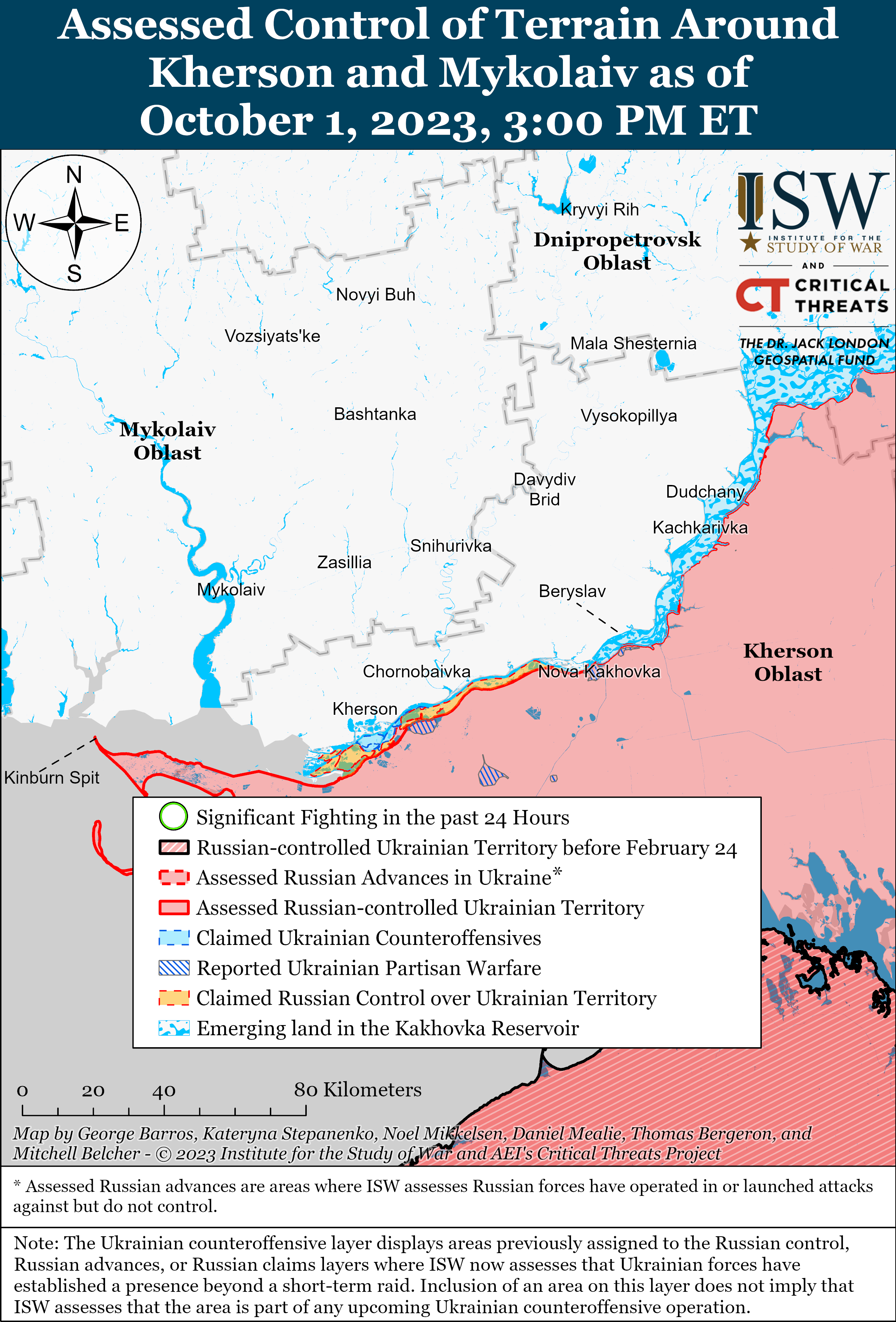
Russian sources claimed that Ukraine fired two “Hrim-2” missiles at occupied Crimea on October 1. The Russian Ministry of Defense (MoD) claimed that Russian air defense shot down two “Hrim-2” missiles over Dzhankoy, and that some debris fell on the Dzhankoy area.[72] The Ukrainian Resistance Center noted that Russian forces are transferring air defense equipment to Simferopol, likely in an effort to further augment Russian air defense capabilities in occupied Crimea.[73]
Russian Mobilization and Force Generation Efforts (Russian objective: Expand combat power without conducting general mobilization)
The Russian Ministry of Defense (MoD) officially announced the beginning of its regular fall 2023 conscription cycle on October 1.[74] The Russian MoD announced that Russian authorities will call up 130,000 conscripts who will train with formations for five months, and then be assigned to their units.[75] The MoD explicitly stated that conscripts will not deploy to occupied Donetsk, Luhansk, Zaporizhia, or Kherson oblasts or participate in combat operations in Ukraine.[76] Ukrainian Luhansk Oblast Head Artem Lysohor noted on October 1 that Russian authorities are also conscripting people in occupied Ukraine.[77] Russian authorities are steadily increasing penalties for ignoring conscription notices: Russian authorities increased fines for ignoring a summons from 3,000 to 30,000 rubles ($31 to $310), introduced new fine up to 500,000 rubles ($5,181) for organizations that do not provide enlistment offices information to issue summons, and banned summoned conscripts from leaving Russia.[78]
Russian military administrators continue facing problems granting benefits to fighters of irregular units due to their informal status under Russian law. The Vostok Battalion claimed on October 1 that an irregular unit, likely referring to the Donetsk People's Republic's “Kaskad” formation, did not receive state awards for its participation in combat when other regular units did because the unit formation exists outside of Russia’s “legal framework” as a relic from when the Donetsk People’s Republic (DNR) was not officially part of the Russian Federation.[79] The Vostok Battalion complained that the unit’s personnel cannot receive combat veterans benefits despite serving as part of a frontline unit, whereas noncombatant Russian National Guard personnel did receive benefits when performing security duties in the rear.[80]
A Kremlin-linked milblogger complained that the attritional fighting and a lack of infantry have degraded formerly “elite” Russian Spetsnaz, Airborne Forces, and Naval Infantry units into “ordinary trash.”[81] The source stated that these units used to be elite prior to Russia’s full-scale invasion of Ukraine but that the Russian military has turned all their forces into infantry because there is a great need for infantry.[82] The source acknowledged that there is a lack of Russian infantry but argued that the Russian military should consider how to improve the quality of Russia’s regular infantry and then think about how to employ elite forces more appropriately instead of using elite forces as a stopgap for regular infantry’s short fallings for convenience's sake.[83]
Activities in Russian-occupied areas (Russian objective: Consolidate administrative control of annexed areas; forcibly integrate Ukrainian citizens into Russian sociocultural, economic, military, and governance systems)
Nothing significant to report.
Significant activity in Belarus (Russian efforts to increase its military presence in Belarus and further integrate Belarus into Russian-favorable frameworks and Wagner Group activity in Belarus)
Wagner Group trainers in Belarus may have provided Belarusian territorial defense elements captured Ukrainian vehicles for tactical training. The Belarusian Ministry of Defense (MoD) posted photos on September 25 showing Belarusian Mogilev territorial defense forces using a Ukrainian-made KrAZ Cobra vehicle (very likely captured from Ukrainian forces) at the Osipovichi Training Ground.[84] A Russian source hypothesized that Russian forces may have given the captured vehicle to Belarus following the withdrawal from Kyiv in early 2022 or Wagner Group forces used it in training following their relocation to Belarus.[85]
ISW will continue to report daily observed Russian and Belarusian military activity in Belarus as part of ongoing Kremlin efforts to increase their control over Belarus and other Russian actions in Belarus.
Note: ISW does not receive any classified material from any source, uses only publicly available information, and draws extensively on Russian, Ukrainian, and Western reporting and social media as well as commercially available satellite imagery and other geospatial data as the basis for these reports. References to all sources used are provided in the endnotes of each update.
[1] https://twitter.com/solonko1648/status/1708204916299170013?t=ErUgFzMKdHBvOB3TfNByTA&s=19
[2] https://twitter.com/moklasen/status/1702000252813824344; https://t.me/dva_majors/25431
[3] https://twitter.com/solonko1648/status/1708204916299170013
[4] https://twitter.com/solonko1648/status/1708204916299170013
[5] https://twitter.com/VigorousFalcon/status/1708512338754908493; https://t.me/ZA_FROHT/22409
[6] https://www.telegraph.co.uk/politics/2023/09/30/grant-shapps-to-send-uk-troops-to-ukraine/; https://www.telegraph.co.uk/politics/2023/09/30/grant-shapps-interview-migrants-ukraine-russia-nato/
[7] https://www.reuters.com/world/europe/uk-aims-offer-military-training-inside-ukraine-minister-says-2023-09-30/
[8] https://www.reuters.com/world/europe/uk-aims-offer-military-training-inside-ukraine-minister-says-2023-09-30/
[9] https://t.me/medvedev_telegram/391
[10] https://www.understandingwar.org/backgrounder/russian-offensive-campaign-assessment-september-30-2023 ; https://understandingwar.org/backgrounder/russian-offensive-campaign-assessment-july-3-2023
[13] https://www.understandingwar.org/backgrounder/russian-offensive-campaign-assessment-august-17-2023 ; https://www.understandingwar.org/backgrounder/russian-offensive-campaign-assessment-september-22-2023 ; https://www.understandingwar.org/backgrounder/russian-offensive-campaign-assessment-september-22-2023 ; https://isw.pub/UkrWar081423
[15] https://www.understandingwar.org/backgrounder/russian-offensive-campaign-assessment-september-29-2023; http://kremlin dot ru/events/president/news/72391
[18] https://t.me/vchkogpu/42162
[20] https://www.facebook.com/GeneralStaff.ua/posts/pfbid02bQ4TcbgQb5i4rMCzmcidLwqTf5xQwYRS8FLz5JhQXTFYaCVMxZB1FFb2PETpqpV8l ; https://www.facebook.com/GeneralStaff.ua/posts/pfbid02mSG1M2Awj1CaEND3JPUEoMSBeejTs6g64qzso7MxKAxisAmhWPXpKBMxxhe24QFgl
[21] https://suspilne dot media/584315-ignat-poasniv-comu-ne-zavzdi-vdaetsa-zbiti-vsi-sahedi/
[22] https://suspilne dot media/584315-ignat-poasniv-comu-ne-zavzdi-vdaetsa-zbiti-vsi-sahedi/
[23] https://t.me/milinfolive/107353
[24] https://t.me/boris_rozhin/98979 ; https://t.me/voenkorKotenok/50912
[25] https://t.me/wargonzo/15389
[26] https://armyinform.com dot ua/2023/10/01/vorog-zoseredyv-u-bahmuti-ponad-10-tysyach-zhyvoyi-syly-illya-yevlash/; https://t.me/luhanskaVTSA/13979
[27] https://t.me/RVvoenkor/53982
[28] https://armyinform.com dot ua/2023/10/01/vorog-zoseredyv-u-bahmuti-ponad-10-tysyach-zhyvoyi-syly-illya-yevlash/; https://t.me/luhanskaVTSA/13979
[29] https://t.me/mod_russia/31036
[30] https://t.me/boris_rozhin/98979 ; https://t.me/voenkorKotenok/50912
[31] https://twitter.com/franfran2424/status/1708201819237658797
[32] https://twitter.com/VigorousFalcon/status/1708527006152028289; https://twitter.com/VigorousFalcon/status/1708527383912022383;
[35] https://www.facebook.com/GeneralStaff.ua/posts/pfbid0WSqcJodJQbZPEv6BGTP32Jkq7SbUR7pY7n6EafVJBFSGpq3Vz94KHCz5caj3tgsSl ; https://www.facebook.com/GeneralStaff.ua/posts/pfbid02bQ4TcbgQb5i4rMCzmcidLwqTf5xQwYRS8FLz5JhQXTFYaCVMxZB1FFb2PETpqpV8l
[36] https://armyinform.com dot ua/2023/10/01/vorog-zoseredyv-u-bahmuti-ponad-10-tysyach-zhyvoyi-syly-illya-yevlash/
[37] https://t.me/wargonzo/15389 ; https://t.me/boris_rozhin/98979 ; https://t.me/voenkorKotenok/50912
[38] https://t.me/wargonzo/15380
[39] https://t.me/boris_rozhin/98979 ; https://t.me/voenkorKotenok/50912
[42] https://t.me/boris_rozhin/98979 ; https://t.me/voenkorKotenok/50912 ; https://t.me/readovkanews/66934
[44] https://www.facebook.com/GeneralStaff.ua/posts/pfbid02bQ4TcbgQb5i4rMCzmcidLwqTf5xQwYRS8FLz5JhQXTFYaCVMxZB1FFb2PETpqpV8l ; https://www.facebook.com/GeneralStaff.ua/posts/pfbid0WSqcJodJQbZPEv6BGTP32Jkq7SbUR7pY7n6EafVJBFSGpq3Vz94KHCz5caj3tgsSl
[46] https://t.me/readovkanews/66934
[52] https://www.facebook.com/GeneralStaff.ua/posts/pfbid02bQ4TcbgQb5i4rMCzmcidLwqTf5xQwYRS8FLz5JhQXTFYaCVMxZB1FFb2PETpqpV8l
[56] https://twitter.com/auditor_ya/status/1708211617052180828; https://t.me/BOBRMORF/273; https://t.me/BOBRMORF/272
[57] https://t.me/mod_russia/31036
[64] https://t.me/combatfootageua/7505; https://t.me/kiber_boroshno/4293; https://twitter.com/solonko1648/status/1708204916299170013?t=ErUgFzMKdHBvOB3TfNByTA&s=19
[65] https://twitter.com/moklasen/status/1708504293332988017; https://t.me/molotgryup/284
[66] https://www.facebook.com/GeneralStaff.ua/posts/pfbid0WSqcJodJQbZPEv6BGTP32Jkq7SbUR7pY7n6EafVJBFSGpq3Vz94KHCz5caj3tgsSl
[67] https://t.me/wargonzo/15380 ; https://t.me/polk1430/1211
[69] https://armyinform.com dot ua/2023/10/01/cziyeyi-nochi-po-hersonshhyni-vorog-vypustyv-16-kerovanyh-aviaczijnyh-bomb-nataliya-gumenyuk/
[71] https://t.me/milinfolive/107362
[72] https://t.me/mod_russia/31035; https://t.me/Aksenov82/3190 ; https://t.me/RVvoenkor/53971 ; https://t.me/russkiy_opolchenec/38166 ; https://t.me/rsotmdivision/10921 ; https://t.me/vchkogpu/42176
[73] https://sprotyv.mod.gov dot ua/okupanty-posylyuyut-oboronu-tymchasovo-okupovanogo-krymu/
[74] https://t.me/mod_russia/31015
[75] https://t.me/mod_russia/31015
[76] https://t.me/mod_russia/31015
[77] https://t.me/luhanskaVTSA/13966
[78] https://t.me/sotaproject/67273
[81] https://t.me/Sladkov_plus/8668
[82] https://t.me/Sladkov_plus/8668
[83] https://t.me/Sladkov_plus/8668
[84] https://t.me/modmilby/32351
[85] https://t.me/milinfolive/107316
